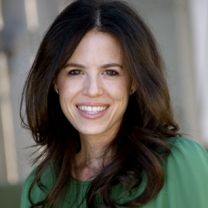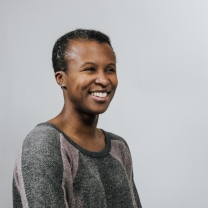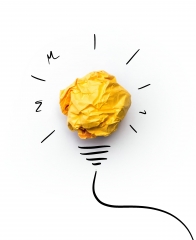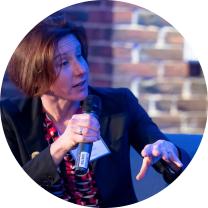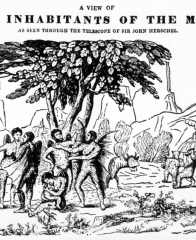 / Try Not. Do or Do Not. –Yoda
Subscribe
/ Try Not. Do or Do Not. –Yoda
Subscribe

When you study decision-making, you can’t help but think about your own brain and how it, too, makes decisions. For example, why did I decide to begin researching decisions? Growing up, I was fortunate to have the opportunity to go to New York City in the summer with my family to see the latest theater. In addition to seeing wonderful shows, one of my favorite things to do on that trip was to find and eat soft, hot pretzels. I would usually smell them before I could see where they were being sold. With the warm salty smell still in my nose, I’d focus my visual attention on finding the pretzel cart. I would strain to see my surroundings through the dense crowds on the busy street corner, convinced I would never be tall enough to see past the sea of towering heads and shoulders. I would fight to hold on to the pretzel smell despite the potpourri of summer odors that emanate from the city concrete on a hot and humid day. I would ignore things that usually grabbed my attention such as toy stores, ice cream and hot dog stands, and the Bloomingdale’s window as I impatiently waited for a break in traffic to dart across the street so as not to lose the pretzel odor trail. Once my eyes spotted the pretzel cart and my nose confirmed there were fresh pretzels waiting, my brain directed the muscles in my legs to take me to the cart.
I can without a doubt say that my interest in trying to understand the electrical and chemical communications in the brain that drive decision-making and, ultimately, behavior began way back on those pretzel-searching, play-watching NYC family trips. Sitting in the theater, I wondered: What drove a character to say or do something? Why did the playwright write it that way? Why did the director decide to set Hamlet in the 1950s? These early questions and experiences informed my passion for science which has, at its heart, a strong foundation in the arts and humanities. My interest in the theater and neuroscience were both fostered as a student at Wellesley and I was lucky to be learning in an environment where my professors saw the value in each discipline, both individually and how together they could amount to more than the sum of their parts. The most important thing I learned from my theater training is the ability to be comfortable with failure. There is something about playing a part that gives an actor the freedom to take risks and fail because there is someone in between them and the failure---the character.
A lot was happening in my brain during the moments leading up to that first warm, soft pretzel bite or the moment the curtain rose on the stage, starting with identifying and assigning subjective value to all of the salient sensory stimuli in my environment. It’s not only when in search of food or entertainment that this happens. Indeed, we are all constantly making decisions. And, most of the time, we are unaware that we are assigning value to and prioritizing sensory information, ignoring background information and generating behaviors based upon these assessments. Dear reader, you are doing it right now! You have, and I thank you, prioritized reading this article over, for example, finishing a project for work, folding your laundry, or watching the latest episode of your favorite television show. We, or at least I, have taken for granted the fact that we, along with other organisms, have evolved this truly incredible ability to discriminate, identify, and assign subjective value to salient sensory information even amidst a noisy sensory backdrop. The integration of multisensory cues, such as odor and vision, can therefore serve to inform and reinforce which environmental cues are indeed salient and which are background noise and can be ignored.
How does the brain permit this? The neural circuits performing these assessments must be both flexible enough to accommodate different external environments yet sufficiently stereotyped to produce adaptive behavioral outputs. For example, while I assigned a more positive value to the pretzel than to the traffic, I prioritized paying attention to the traffic more than my desire to get to the pretzel cart in order to stay safe so that I could continue my quest. However, it’s not quite that simple, for we must also consider our internal state. If I have just had a big meal and am not hungry, I might not assign as positive a value to the pretzel, perhaps preferring window shopping at Bloomingdales thus resulting in a different behavioral output. In other words, a single sensory input might elicit a variety of outputs depending upon the internal or external state of the animal.
In addition to trying to understand the computations in the brain that permit multisensory integration that underlies daily decision-making, several neurological disorders such as ADHD, schizophrenia, autism, and multisensory integration disorder are the result of missteps in multimodal integration. In these cases, individuals often have difficulty either identifying salient stimuli from background noise or assigning a value to a stimulus. These difficulties lead to a maladaptive behavioral output. Although we and other organisms rely on constant integration and updating of our internal and external environment, we know little about the neuronal mechanisms that support this. The complexity of the mammalian nervous system precludes a molecular understanding of the processes underlying multisensory integration. In contrast, the fruit fly, D. melanogaster, is an ideal model for examining the neuronal and molecular basis for multimodal integration because of its numerically limited nervous system, extensive behavioral repertoire, sequenced genome, and array of genetic and physiological tools. For these reasons, the fruit fly is the focus of research in my lab.
I am grateful to all the pretzel carts I discovered and to the characters I played, wrote, and directed, all of which introduced me to the amazing things that can come from exploring, risking, failing, and trying again. This comfort with failure is what allows me to ask nontraditional research questions or to try a new approach, knowing and being at peace with the fact that it probably won’t work the first several times. But what I learn from my failures about myself and my research becomes the inspiration for that next step. For this reason, failures are always worth it in the end. All of my failures so far have led me back to Wellesley---where my failures were first celebrated---and I can’t wait to see how the comfort with failure my students are cultivating now will inform their risk-taking and decision-making in the boardroom, on the field, in the concert hall, or wherever their post-graduation path leads.
Photo credit: Studiotouch, "Male common fruit fly (Drosophila Melanogaster) sitting on a blade of grass with green foliage background," via. Shutterstock, 1 March 2018.
